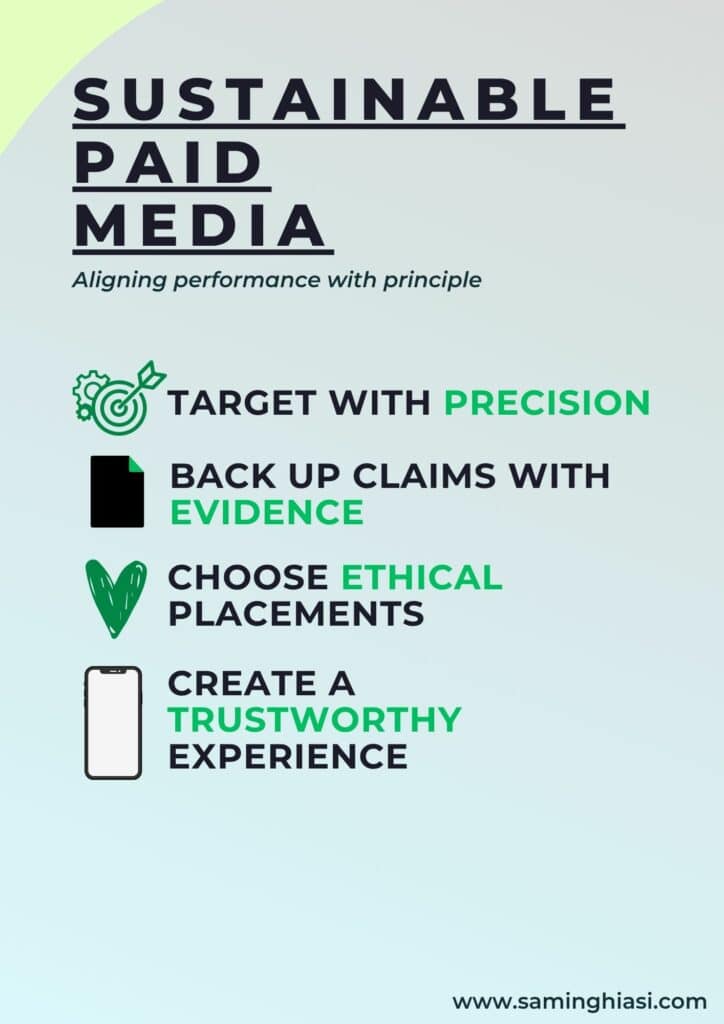Reading time: 8 minutes
Part 8 of the July blog series on The Growth Ethos. Subscribe to follow it.

Performance doesn’t have to feel extractive
If you’ve read Part 7 on dark social and micro‑communities, you’ll recognise how trust is built through quiet recommendation. This post picks up from there, exploring how paid media can work the same way, without compromising your values.
For mission-driven organisations, advertising often feels like a compromise: rapid reach at the cost of credibility. But with thoughtful design, paid media can do more than convert—it can reinforce trust.
“Here’s how leading brands are aligning performance with principle, using data-backed strategies that deliver real, measurable impact.”
1. Precision as performance
Blanket targeting is falling out of fashion, fast. DoubleVerify and Scope3 tracked over a trillion impressions in 2023. Their findings? Shifting to high-integrity, brand-safe ad placements helped avoid nearly 65,000 tonnes of CO₂ emissions globally. Irrelevant media not only underperforms—it pollutes the funnel [1].
The takeaway is simple: reach without relevance is just noise. Real impact happens where attention meets intent.
2. Authenticity beats aspiration
The stakes for sustainability claims are higher than ever. A 2025 EU review found that around 53.3% of green claims on websites were vague, misleading, or unverifiable [2]. That prompted lobbying for the Green Claims Directive, even though its passage stalled [3].
Brands gaining trust now do more than talk. They publish data. Ecosia, for instance, publishes monthly financial reports and has rolled out a live “impact counter” so users can see exactly how many trees have been planted via their searches [4]. That kind of transparency earns credibility over cleverness.
3. Carbon as part of creative briefs
Every digital impression carries a carbon cost. Some formats emit as much as 1 gram of CO₂ per impression—so a million impressions can equal a tonne emitted [5].
Scope3’s carbon-per-mille tools, especially when integrated with Broadsign’s DOOH inventory, show that digital-out-of-home ads often produce lower emissions per impression than mobile or web video [6].
That means emissions-aware media planning is necessary. Budget more than money. Budget impact, too.
4. Selecting media that reflects your values
Algorithms optimise for cost and volume. DoubleVerify’s DV Authentic Rate frames this: campaigns using high-quality inventory emitted around 21% less carbon per impression, while low‑integrity placements emitted up to 44% more and engaged poorly [1][7].
Choosing quality placements isn’t just ethical, it’s strategic. Cleaner media buys drive stronger engagement and smaller footprints.
5. Protect post‑click credibility
Winning the click is just the start. What happens next determines whether trust deepens or dissolves.
Research shows that users form first impressions in as little as 50 milliseconds, and 75% judge a company’s credibility based on its website’s visual design [9][10]. That makes post-click experience as important as the ad itself.
Trustworthy landing pages typically include:
- Consistent tone and messaging between ad and destination
- Fast, responsive page loads
- Minimal tracking and clear consent design
- Plain-language explanations for any data collection
- Hosting that reflects your environmental commitments, where feasible
Post-click is confirmation.
6. Redefining success metrics
Clicks build Community. Impact-first platforms like Too Good To Go illustrate this.
Their app has redistributed over 140 million “Magic Bags”, saving hundreds of thousands of tonnes of food and greenhouse gas emissions and creating a global community of “waste warriors” doing more than transacting; they’re advocating [8].
Look beyond cost per lead:
- Branded search volume after campaigns
- Referral rates from acquired users
- Repeat visits and user retention
- NPS or satisfaction ratings by channel
- Community mentions or platform engagement
Clicks signal interest, and trust converts it into impact.
Summary takeaways
- Impact trumps impression, every time.
- Proof wins over slogans
- Include carbon as part of the campaign strategy
- Choose inventory that aligns with values
- Build landing pages that reinforce your message
- Track relational outcomes—not just campaign metrics
Paid media need not compromise your mission. It can elevate it when every part of the strategy aligns with who you are.
Source references
[1] DoubleVerify & Scope3, 2023 Campaign Insights
[2] 2025 EU Green Claims Review
[3] ESG Today coverage of the Green Claims Directive status
[4] Ecosia’s impact counter via BusinessGreen
[5] Scope3 Carbon Benchmarks
[6] Broadsign + Scope3 partnership on DOOH emissions
[7] DoubleVerify Authentic Rate study
[8] Too Good To Go case profile (Tools of Change)
[9] CXL: First Impressions & Visual Trust Factors
[10] Stanford Web Credibility Guidelines
WHAT’S NEXT IN THIS SERIES
This is part 8 of The Growth Ethos, a 10-post series exploring smarter, more sustainable ways to scale in 2025.
Coming next:
→ SEO for Good: Content That Powers Purpose and Growth
LET’S BUILD SOMETHING BETTER
If you’re building a product, service, or strategy that values long-term trust and responsible growth—this series is for you.
📬 Subscribe to the newsletter and get each new post delivered as it drops. No noise, just real thinking in motion.